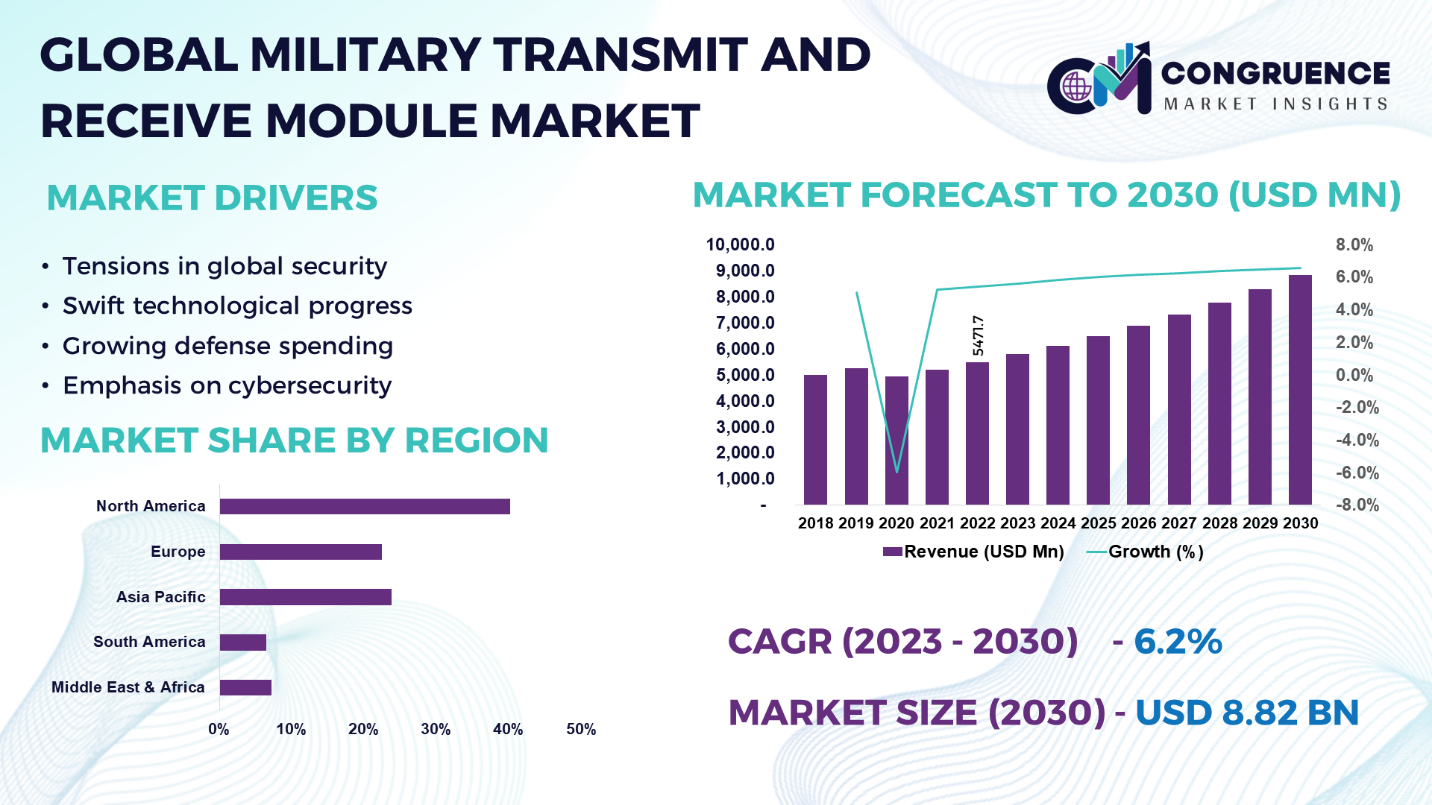Reports
The Global Military Transmit and Receive Module Market was valued at USD 5,471.7 Million in 2022 and is anticipated to reach a value of USD 8,817.8 Million by 2030 expanding at a CAGR of 6.2% between 2023 and 2030.
The technology that allows armed forces devices to communicate with one another is called a Military Transmit and Receive Module (MTRM). For radios, radar equipment, and other high-tech military gear, it serves as a middleman. This module is designed to withstand the harsh climatic and environmental conditions during military operations. It is also extremely dependable. Encryption and intelligent signal processing are only a couple of the sophisticated technologies that ensure the security of the data being transferred. When it comes to keeping military communication at the highest level and assisting them in staying informed and in control of situations in the field, the MTRM is essentially the magic ingredient. The global market for military transmit and receive modules is essentially the main commercial arena for all the innovative technology that enables military devices to communicate with each other around the globe. It's similar to the market where businesses sell these robust, sophisticated modules that facilitate communication amongst military equipment. There are numerous competitors in this competitive market, so players have to make sure that their equipment is dependable and equipped with features such as encryption and intelligent signal processing. It's very vital for these modules since they serve as the foundation for military communication, enabling militaries to stay informed and linked. In short, it's the global center for the purchase and sale of the proprietary knowledge that maintains the military in communication and coordination.

Military Transmit and Receive Module Market Major Driving Forces
Tensions in Global Security: As terrorist attacks and geopolitical unrest continue to rise, there is a greater focus on national security. Governments all over the world are therefore investing extensively in defense infrastructure to effectively as well as easily tackle any form of national danger, which is fueling the MTRM industry.
Swift Technological Progress: Governments worldwide are making significant investments in defense equipment research and development, which helps to develop strong encryption algorithms, sophisticated signal processing, and improved frequency modulation strategies. MTRM is able to grow its market share due to their innovative technology solutions.
Growing Defense spending: An important aspect affecting market dynamics is the rise in defense spending across different countries. Governments are investing more in cutting-edge communication technologies which is made possible by increased defense spending, and hence, boosts demand for military transmit and receive modules.
Emphasis on Cybersecurity: A larger focus is on producing military equipment that is resistant to cyberattacks. Another growing worldwide concern is cyber terrorism, which calls for strong encryption, especially in the military sector given the sensitive nature of the data. The ideal tool for efficient communication without having to worry about cybersecurity is the MTRM.
Military Transmit and Receive Module Market Key Opportunities
Emergence of 5G Technology: The advent of 5G technology promises faster data transfers, lower latency, and better connectivity. All of which contribute to the speedy military communications that are necessary to fulfill the needs of modern, developing military operations.
Cyberattack Resiliency: The increasing frequency of cyberattacks, particularly in the defense industry, is a glaring concern for militaries worldwide. In the expanding MTRM industry, the military transmit and receive module, which can strengthen military communication's resistance to cyberattacks, is undoubtedly going to acquire more traction.
Customization for Specialized Activities: The need for specialized transmit and receive modules arises from the need for military activities such as electronic warfare and intelligence collection. Manufacturers that meet particular operational requirements—such as encryption standards and frequency bands—can benefit from specialized markets inside the larger military communication industry.
Military Transmit and Receive Module Market Key Trends
· Military operations' growing reliance on unmanned systems.
· There is a tendency in military communication towards increasing developments in satellite communication systems.
· Expanding 5G networks will offer better field connectivity, lower latency, and quicker data rates.
· Advanced cybersecurity measures that increase resilience are being integrated in response to the growing threat of cyberattacks.
· Specialized electronic military operations are becoming more and more common.
· Alliances and cooperative defense initiatives are having an impact on the industry.
· AI-driven communication procedures are being supported by transmit and receive modules, which are becoming prevalent in the integration of AI technology into military operations.
Region-wise Market Insights
North America accounted for the largest market share at 40.1 % in 2022 whereas, Asia Pacific is expected to register the fastest growth, expanding at a CAGR of 7.1% between 2023 and 2030.

With a market share of 40.1% and USD 2,194.2 million in the global military transmit and receive module market, North America holds the greatest share. Growing emphasis on space-based communication, allied forces collaboration, advanced research and development (R&D) activities, focus on C4ISR systems, military alliances and joint operations, rapid adoption of advanced technologies, geopolitical tensions, focus on homeland security, critical infrastructure protection, adoption of next-generation networks, and growing emphasis on naval capabilities are the factors driving the market in this region. With a CAGR of 7.1%, the Asia-Pacific area has the fastest growth rate. The market in this region is driven by the factors such as increased emphasis on projecting naval power, technological catch-up, cybersecurity readiness, formation of strategic alliances and partnerships, preparedness for natural disasters, increasing regional influence, advancements in space-based communication, trends in electronic warfare, investment in domestic defense industries, requirements for global connectivity, increasing demand for specialized communication solutions, cyber resilience in communication networks, and adoption of next-generation technologies.
Market Competition Landscape
The competitive environment of the military transmits and receive module market is defined by the existence of both domestic and international rivals. The military transmit and receive module sector has consolidated as a result of mergers and acquisitions, wherein larger companies have acquired smaller firms in order to strengthen their market position and expand their capabilities. Due to this trend, notable companies with a wide range of products and services and a global presence have emerged. Innovative technologies are being quickly adopted by businesses in the military transmit and receive module market in order to improve project efficiency, and safety from cyber threat.
Businesses having a wide geographic reach are better able to access a variety of markets and possibilities. They can increase their market share and diversify their project portfolio by utilizing their regional or worldwide footprints. Since local and regional pipeline contractors are familiar with local laws, cultural quirks, and project-specific needs, they have an edge over competitors in their particular marketplaces.
Prominent players in the market include:
· Lockheed Martin Corporation
· Raytheon Technologies Corporation
· Northrop Grumman Corporation
· Thales Group
· BAE Systems plc
· L3Harris Technologies
· The Boeing Company
· Rohde & Schwarz GmbH & Co. KG
· Cobham plc
· Saab AB
· Honeywell International Inc.
· LIG Nex1
· Curtiss-Wright Corporation
· Elbit Systems Ltd.
· ITT Inc.
Three major companies in the worldwide aerospace and defense sector are Raytheon Technologies, Northrop Grumman, and Lockheed Martin Corporation. Leading the way in the development of cutting-edge communication technologies, including electronic warfare and secure communication solutions, is Lockheed Martin. As a leader in the development of cutting-edge technology for military use, Raytheon technology advances military communication capabilities. Leading defense contractor Northrop Grumman specializes in electronics and aerospace and develops cutting-edge communication equipment, such as transmit and receive modules, to assist in intelligence collection and military operations. Prominent aerospace and defense corporation Boeing Company also specializes in military communication solutions, such as electronic warfare technology and satellite communication systems.
|
Report Attribute/Metric |
Details |
|
Market Revenue in 2022 |
USD 5,471.7 Million |
|
Market Revenue in 2030 |
USD 8,817.8 Million |
|
CAGR (2023 – 2030) |
6.2% |
|
Base Year |
2022 |
|
Forecast Period |
2023 – 2030 |
|
Historical Data |
2018 to 2022 |
|
Forecast Unit |
Value (US$ Mn) |
|
Key Report Deliverable |
Revenue Forecast, Growth Trends, Market Dynamics, Segmental Overview, Regional and Country-wise Analysis, Competition Landscape |
|
Segments Covered |
· By Type (Ground-based, Airborne, Naval, Space-based) · By Frequency Band (UHF, VHF, SHF, EHF) · By Technology (Analog, Digital) · By End User (Army, Navy, Air Force, Special Forces, Intelligence Agencies) · By Application (Communication, Electronic Warfare, Radar, Surveillance, Navigation, Unmanned Systems) |
|
Geographies Covered |
North America: U.S., Canada and Mexico Europe: Germany, France, U.K., Italy, Spain, and Rest of Europe Asia Pacific: China, India, Japan, South Korea, Southeast Asia, and Rest of Asia Pacific South America: Brazil, Argentina, and Rest of Latin America Middle East & Africa: GCC Countries, South Africa, and Rest of Middle East & Africa |
|
Key Players Analyzed |
Lockheed Martin, Raytheon Technologies, Northrop Grumman, Thales Group, BAE Systems, L3Harris Technologies, Boeing, Rohde & Schwarz, Cobham, Saab, Honeywell, LIG Nex1, Curtiss-Wright, Elbit Systems, ITT Inc. |
|
Customization & Pricing |
Available on Request (10% Customization is Free) |
